This past year saw no shortage of controversies in both the art world and the real world. And perhaps more than ever before, the distance between those two worlds seemed to collapse, as artists and activists began demanding with unprecedented strength that patrons—both board members and corporate sponsors—answer for their actions outside the confines of the museum. We zeroed in on 11 hot-button issues that ignited heated debate in the art world this year, and the particular questions they provoked.
It would be wise to brush up: we expect the conversations to continue into 2020 and beyond.
How Do You Know When a Board Member Is Too Tainted?
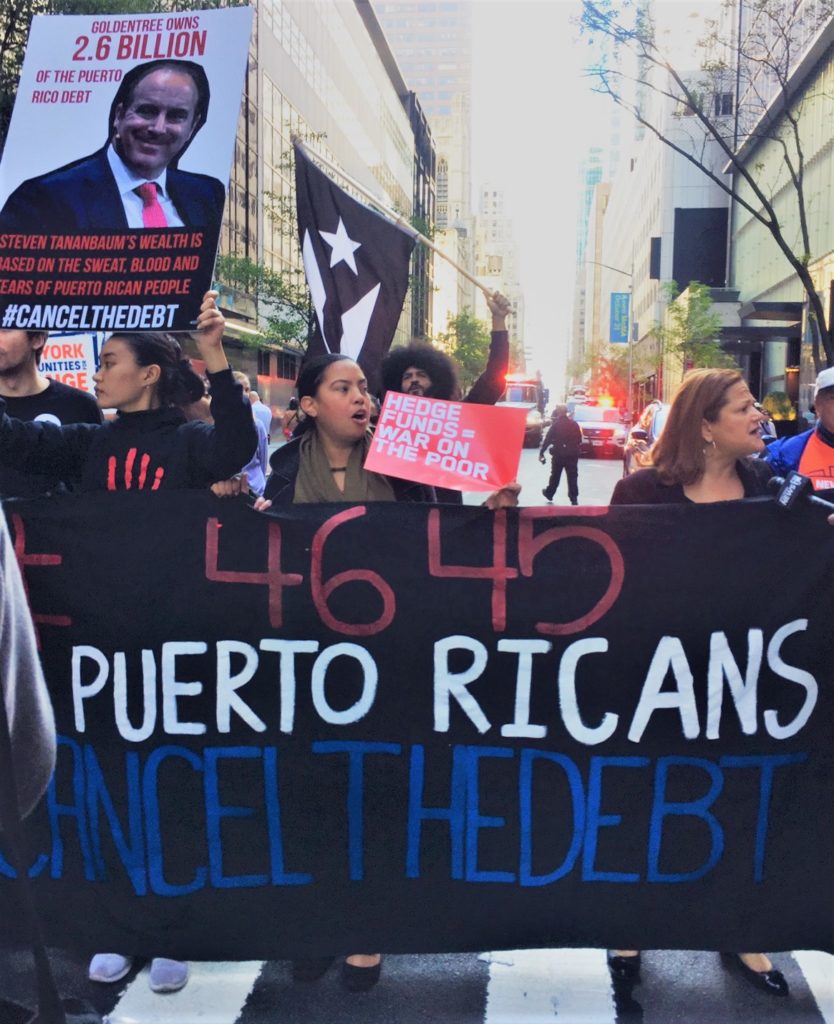
#CancelTheDebt protesters from New York Communities for Change demonstrate against trustee Steven Tananbaum at the October 21 opening of the expanded Museum of Modern Art. Image: Eileen Kinsella.
When protesters gathered at the Whitney Museum of American Art in December 2018 to protest the presence of Warren B. Kanders, the CEO of Safariland, on its board of trustees, few could have imagined that seven months later, Kanders would step down. Way back in the olden days of 2018, board members seemed untouchable, operating in a different stratosphere from grassroots demonstrators who sought to draw attention to weapons-manufacturer Safariland’s use of tear gas at the US border. But after weeks of regular protests in the lobby of the Whitney led by the group Decolonize This Place, a forceful Artforum essay, and the decision by eight artists to withdraw their work midway through the Whitney Biennial, what once seemed impossible suddenly became a reality: Kanders left the board, saying he did not “wish to play a role, however inadvertent, in [the Whitney’s] demise.”
The uproar surrounding Kanders was the first, but hardly the only, example of board members coming under fire for the source of their wealth or their family’s wealth. Over the summer, Serpentine Galleries director Yana Peel resigned following reports alleging a connection between her husband and a controversial Israeli cyber-weapons company. (Her husband has denied the spyware was ever used inappropriately; Peel said her decision was the result of “a concerted lobbying campaign.”)
Later in the year, activists trained their sights on MoMA board member Steven Tananbaum who, they said, “made his money at the cost of closing schools, cutting retirement pensions and other services in Puerto Rico.” The group called Tananbaum’s hedge fund, Golden Tree, “one of the most aggressive vulture funds taking advantage of Puerto Rico’s debt crisis.” Local politician Melissa-Mark Viverito was arrested, along with roughly a dozen other activists, when they refused to leave the street directly in front of the museum during a demonstration tied to MoMA’s grand reopening. Tananbaum remains on the board.
Has the Sackler Name Finally Become Too Toxic for Museums?
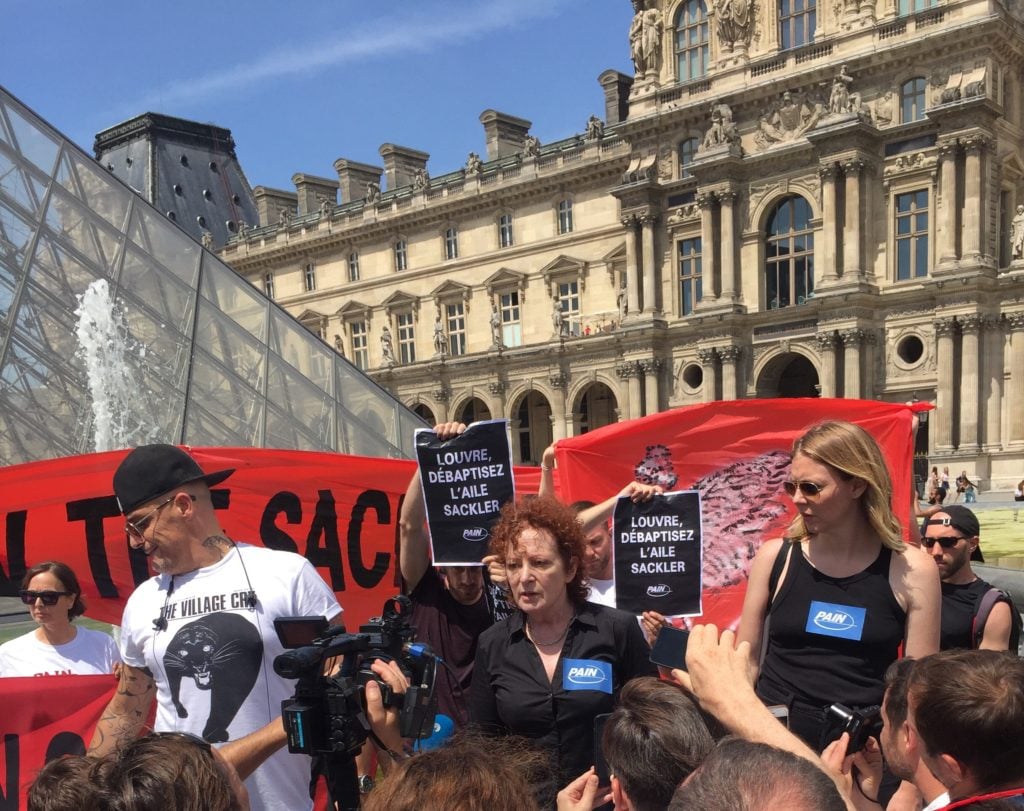
Nan Goldin speaking at the protest outside the Louvre. Photo courtesy Sackler P.A.I.N.
The debate over the Sackler family’s cultural philanthropy is another controversy that began stirring in late 2018, but remained at the fringes of the cultural conversation until it became impossible to ignore this year. In the early months of 2019, artist Nan Goldin, who battled opioid addiction herself, continued staging regular demonstrations at museums that had halls named after the Sackler family, including the Metropolitan Museum of Art. Then, in March, something that had only recently seemed unthinkable happened: the National Portrait Gallery in London announced it would not accept a $1.3 million gift from the Sackler family amid multiplying US lawsuits that alleged certain branches of the clan had engaged in deception and misconduct to promote OxyContin despite the public health risks associated with it.
After that first domino fell, many others followed: the Tate, the Solomon R. Guggenheim Museum, the Met, and other institutions announced they would no longer accept money from the family members involved in the lawsuits or associated with the opioid crisis. The Sackler Trust and the Dr. Mortimer and Theresa Sackler Foundation also announced they would stop all philanthropic giving while the lawsuits were pending. In July, the Louvre in Paris became the first major museum to remove the Sackler name from its walls. Meanwhile, others, such as the V&A in London, have declined to sever ties with the family, which reached tentative settlements in thousands of opioid cases this fall.
Are BP and Other Oil Companies No Longer Desirable Sponsors?
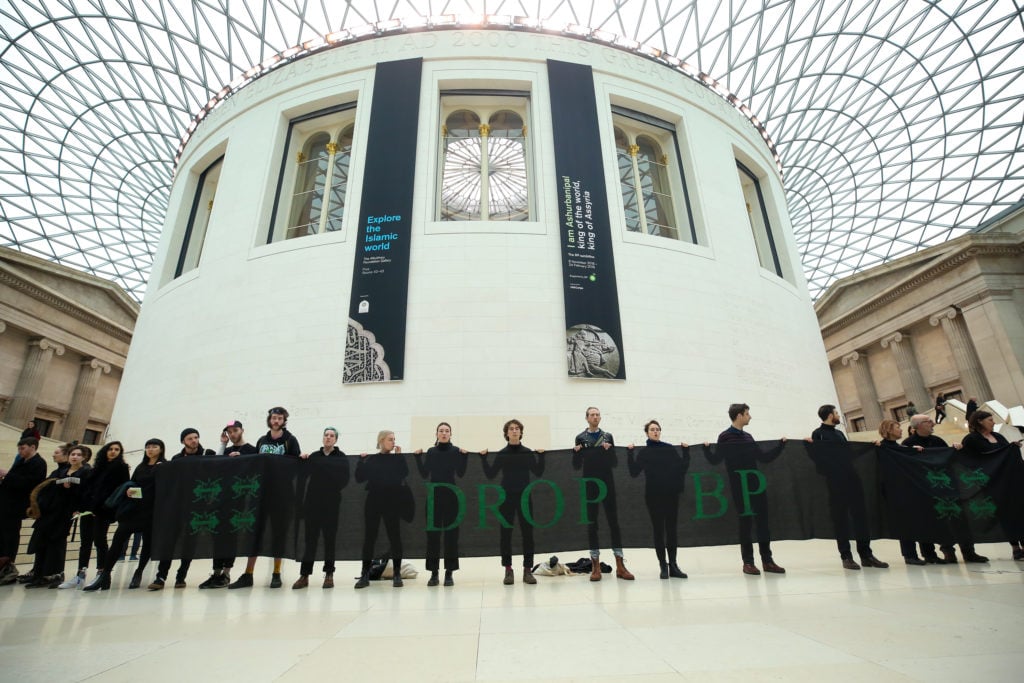
Activists are seen holding a banner during the protest against oil company BP at the British Museum in London, February 2019. Photo: Dinendra Haria/SOPA Images/LightRocket via Getty Images.
Individual donors were not the only museum patrons in the crossfire this year. Activists also stepped up their campaign against BP and other oil-company corporate sponsors of cultural institutions. Hundreds of protesters associated with the group BP or Not To BP? descended on the museum in February to denounce the energy company’s alleged exploitation of Iraq’s oil fields following the Iraq War. They returned again in May, and in November. While such efforts have been gathering steam for years, they hit a louder note in 2019 as museums around the world were forced to reckon with the sources of their funding. And one of the British Museum’s own—trustee Ahdaf Soueif—resigned from her position in July, saying she regretted the institution’s lack of engagement with “the legitimate and pressing concerns of young people across the planet.” That same month, four major cultural institutions in London, including the British Museum, the National Portrait Gallery, the Royal Opera House and the Royal Shakespeare Company, committed to signing a new five-year, £7.5 million ($9.8 million) sponsorship deal with BP.
Where in the World Is Salvator Mundi?
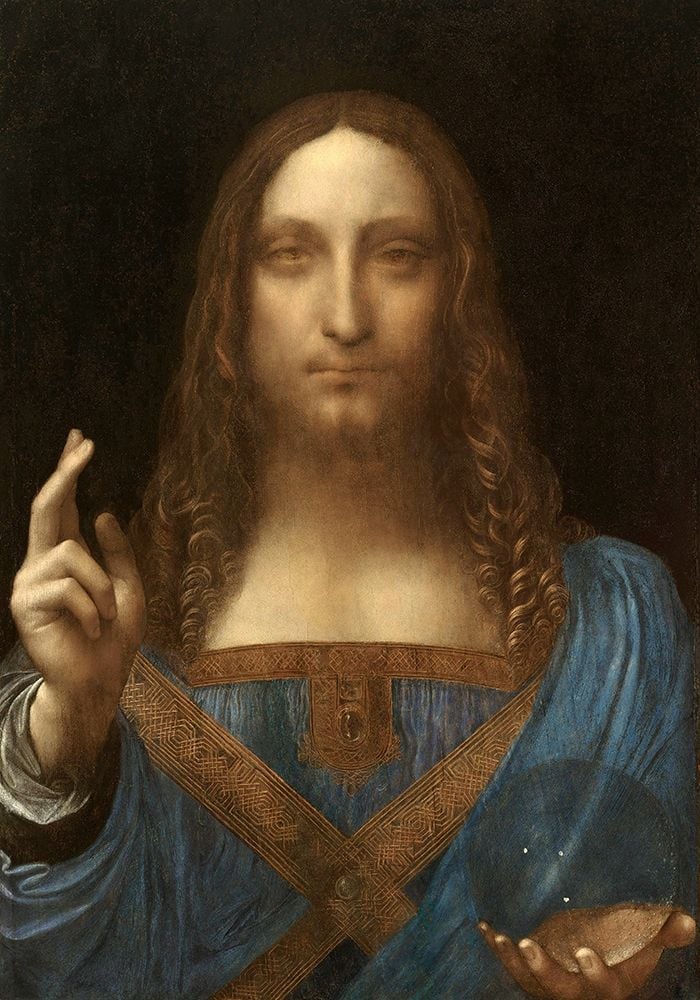
Leonardo da Vinci, Salvator Mundi (ca. 1500). Courtesy of Christie’s Images Ltd.
The art story that just won’t die is the saga of Salvator Mundi, the Leonardo da Vinci painting bought for $450.3 million at Christie’s in 2017—and promptly never seen again. The buyer had been identified in the press as Prince Bader bin Abdullah bin Mohammed bin Farhan Al Saud, a close associate of Saudi crown prince Mohammed Bin Salman, who is said to have donated the work to the Louvre Abu Dhabi as some kind extremely expensive of diplomatic gift. But the painting never went on view in the Emirate as scheduled.
Many Mundi heads had high hopes that the painting would resurface this year, as it was due to be included in the Louvre’s blockbuster Leonardo exhibition, which opened this fall. The museum kept its cards close to the vest, declining to confirm whether or not the painting would be included until the day the show opened, when it was nowhere to be found. To this day, no one is quite sure where the work is—though Artnet News’s intrepid columnist Kenny Schachter reported in June that the work was whisked away on MBS’s plane and is now on his yacht, the Serene, which was seen traveling off its usual course and closer to Europe around the time of the opening of the Louvre show. Will we finally set eyes on the painting again in 2020? Don’t hold your breath.
Is Deaccessioning the Solution to Museums’ Diversity Problem?
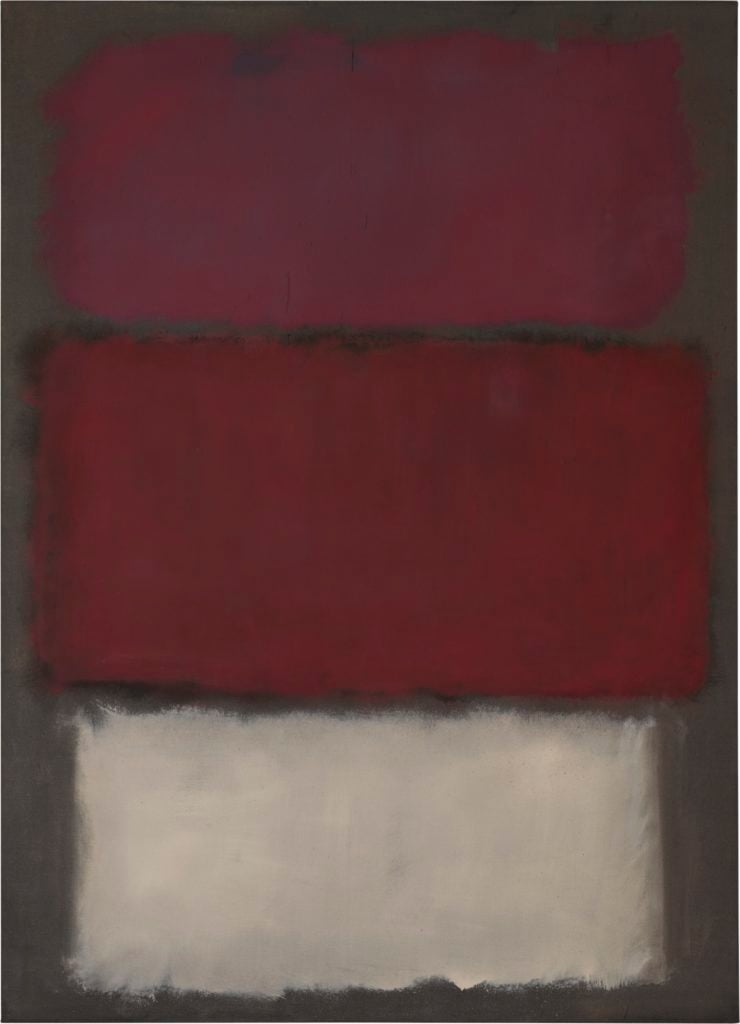
Mark Rothko, Untitled (1960). Sold on behalf of the San Francisco Museum of Modern Art, the painting went for $50 million. Courtesy of Sotheby’s.
As museums made belated efforts to acquire and exhibit the work of female artists and artists of color who they had long overlooked, a growing number of institutions began to adopt a divisive tactic to accomplish their goal: deaccessioning. The always-controversial practice of a museum buying art took on a new angle when, in spring 2018, the Baltimore Museum of Art broadcast its plan to sell seven works by white, male artists for the express purpose of diversifying its collection. Two other major institutions, the San Francisco Museum of Modern Art and the Art Gallery of Ontario, announced similar initiatives this year. SFMOMA’s plan to sell off a Rothko for $50 million helped fund its acquisition of works by Alma Thomas, Lygia Clark, Mickalene Thomas, and more.
Is Christoph Büchel’s Barca Nostra Provocative or Simply Wrong?

The shipwreck being moved from a port near Augusta, Sicily, to Venice for the biennale. The project is being presented by artist Christoph Büchel. © Barca Nostra.
Depending on whom you talked to, rabble-rousing artist Christoph Büchel’s provocative work for the 2019 Venice Biennale—a rusting hulk of a barge that sank in the Mediterranean in 2015, killing 1,100 migrants fleeing North Africa—was “absolutely vile,” or “powerful.” Opinions diverged widely over whether Barca Nostra (Our Boat) was a poignant memorial paying tribute to victims of the tragedy or a vulgar photo op that instrumentalized the death of hundreds to make a cynical point about the art world.
Further complicating the reception of the work? The artist insisted on having no label or descriptive text to provide context. Biennale artistic director Ralph Rugoff explained to one news station that historical context was provided in the exhibition catalogue—but that did little to assuage those who were skeptical of or offended by the work. The artist declined to be interviewed by Artnet News.
What Happens When an Exhibition on Censorship Is Censored?
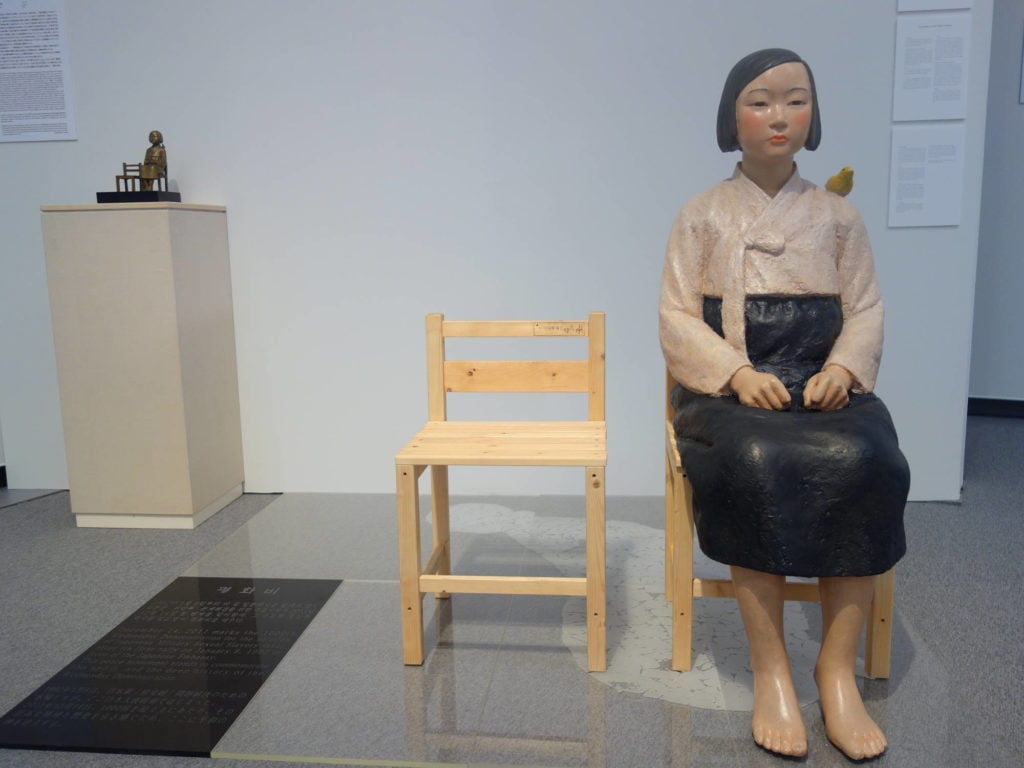
Kim Seo-kyung and Kim Eun-sung, Statue of a Girl of Peace (2011). Courtesy of the artists.
For an exhibition that was on public view for only three days in August before temporarily shutting down, the exhibition “After ‘Freedom of Expression’?” at the 2019 Aichi Triennale has received a heck of a lot of discussion. The show, which examined censorship in Japan, was closed after directors and curators received numerous threats—via email, phone, and even fax—objecting to a controversial work in the show. The piece in question was a life-size figurative sculpture by Korean artists Kim Seo-kyung and Kim Eun-sung, Statue of Peace (2011), that depicts a “comfort woman,” or ianfu—one of the thousands of Asian women forced into sexual slavery by the Japanese military during World War II. The curators of the exhibition called the move a “historic outrage” in a statement. “This will be the worst censorship incident in Japan’s postwar period,” they said. After the decision to remove the work was challenged in the courts and a group of artists, including Claudia Martínez Garay, Tania Bruguera, and Pia Camil, demanded their own art be pulled from view in solidarity, the exhibition eventually reopened in October. But the aftershocks will be felt for a while: the Triennale is investigating exactly what went wrong, while the offending sculpture has been acquired for a forthcoming museum of banned art.
Should the Art World Be Working With Saudi Arabia?

Crown Prince of Saudi Arabia Mohammed bin Salman Al Saud (L) and French President Emmanuel Macron (R) hold a joint press conference at the Elysee Palace in Paris, France on April 10, 2018. Photo by Bandar Algaloud / Saudi Kingdom Council / Handout/Anadolu Agency/Getty Images.
The art world has also had to reckon with its associations with repressive governments in 2019. In October, exactly one year after the murder of dissident Saudi journalist Jamal Khashoggi at a consulate in Istanbul, organizers of the California biennial Desert X said they were launching a new edition next year: in Saudi Arabia. Not surprisingly, the reaction was swift: three of 14 board members resigned in protest, including artist Ed Ruscha, curator Yael Lipschutz, and philanthropist Tristan Milanovich. (The CIA has accused Saudi crown prince Mohammed Bin Salman, known as MBS, of ordering the killing, and the kingdom has been accused of numerous other human rights violations.)
“I resigned because I felt like Desert X no longer reflected my humanitarian values,” Lipschutz told Artnet News at the time. “I don’t want to aid in rebranding Saudi Arabia as a somehow enlightened, credible government.”
This wasn’t the first time associations with Saudi Arabia proved toxic. In March, news broke that Endeavor, the majority owner of the Frieze Art Fair, had quietly returned a hefty investment from the Kingdom. Meanwhile, we reported in January that a number of high profile figures—including Allan Schwartzman, the co-chairman of Sotheby’s fine art division; Irina Bokova, the former Director-General of UNESCO; and Jack Lang, the former culture minister of France—remained on the advisory board for the Saudi Royal Commission of Al-Ula, a region about 200 miles north of Medina that is home to a number of important historical and archaeological sites that Saudi Arabia hopes to transform into a tourist hub.
Should This Mural of George Washington Remain at a San Francisco School?
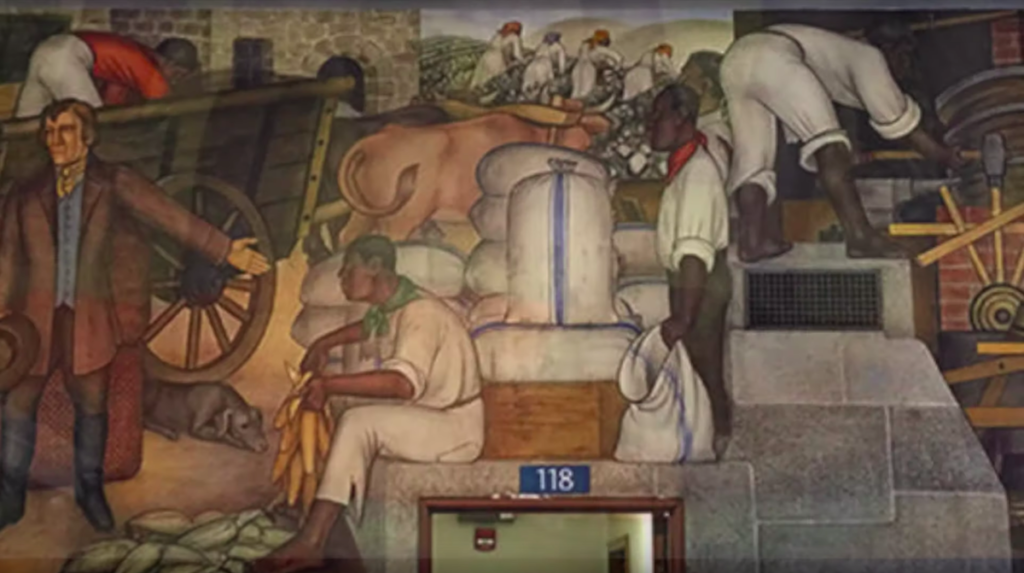
Detail of Victor Arnautoff, The Life of George Washington (1934). Screenshot from GWHS Alumni Assn SF CA on YouTube.
A debate over a set of murals at a San Francisco High School captured the attention of the country, stirring up big questions like: should images of our harmful past be preserved to learn from, or removed so as not to be venerated? What’s more, does it help or hurt students to witness challenging material that may make them uncomfortable in the classroom?
After years of heated debate over these issues, the San Francisco Board of Education voted unanimously to cover up the murals at George Washington High School, a 13-panel painting that shows the violent treatment of Native Americans and slaves. The 90-year-old work was painted by artist Victor Arnautoff, who happened to be a bold critic of the whitewashing of US history. The debate ensnared hundreds of academics and scholars, as well as Pulitzer Prize-winning author and activist Alice Walker. But in the end, the school board decided in a 4-to-3 vote to cover the murals with paneling, keeping them intact while hiding them from the eyes of high schoolers.
Who Should Replace New York’s Monuments to Shameful Men?
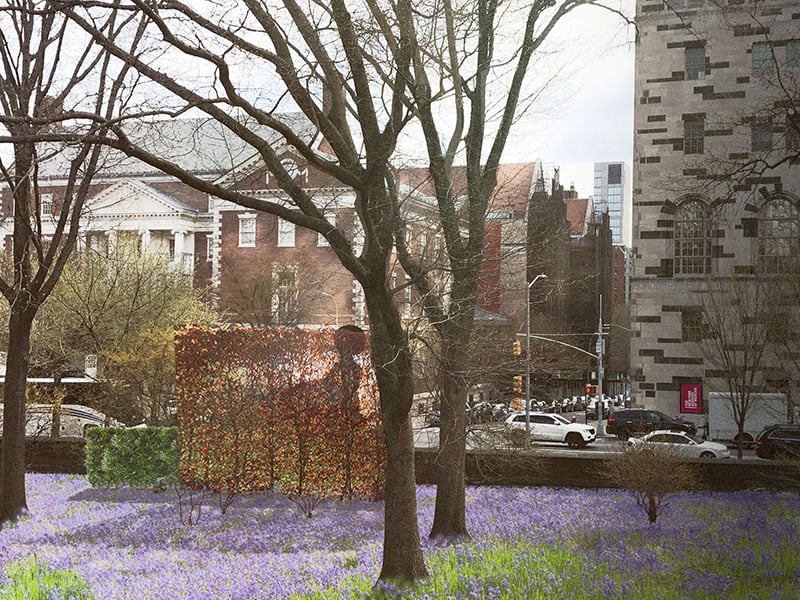
Simone Leigh, After Anarcha, Lucy, Betsey, Henrietta, Laure, and Anonymous (rendering). A panel of experts chose this piece from four proposals being considered for an artwork to replace the monument to J. Marion Sims, the 19th-century doctor who experimented on slaves. Courtesy of the artist.
One would have thought that activists who had campaigned for years to remove a New York City monument to Marion J. Sims—the 19th-century doctor who conducted experiments on enslaved black women—would have been celebrating its removal. Instead, the event touched off a tempest about what would replace it. A panel of experts voted for a piece designed by artist Simone Leigh, whose work has been shown at the Guggenheim Museum as well as in the recent Whitney Biennial. Leigh’s work—a large statue titled Brick House—beat out numerous other artists who competed for the gig. But locals protested the process, throwing their support behind the work of little-known Yonkers-based artist Vinnie Bagwell. Following the contentious vote, culture commissioner Tom Finkelpearl reassured those assembled that the panel’s opinion was advisory, not binding. In October, Leigh withdrew her proposal following the backlash, and the city announced Bagwell would be designing the new monument. The turbulence spurred a hearing of the city council, and debates over the city’s public art are said to have contributed to the departure of Finkelpearl, who resigned abruptly this fall.
Can the Turner Prize Really Be for Everyone?
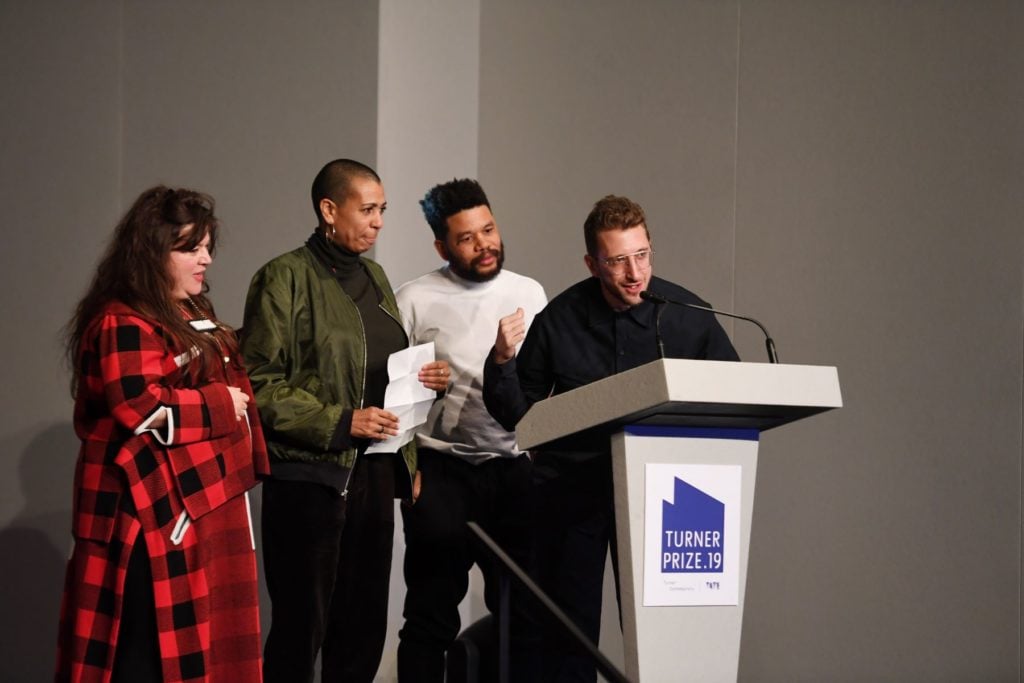
Tai Shani, Helen Cammock, Oscar Murillo and Lawrence Abu Hamdan celebrate after being announced as the joint winners of Turner Prize 2019 by Edward Enninful, Editor-in-Chief of British Vogue in Margate. Photo by Stuart C. Wilson/Stuart Wilson/Getty Images for Turner Contemporary.
In a move that was celebrated and derided in equal measure, the 2019 nominees of the prestigious Turner Prize successfully petitioned for an extremely unexpected outcome: they all won. The artists presented the move as a politically engaged gesture of solidarity in the shadow of Brexit and the UK general election.
Before the winner was announced, Lawrence Abu Hamdan, Helen Cammock, Oscar Murillo, and Tai Shani wrote to the Turner Prize jury asking to accept the prize as a collective in order “to make a statement in the name of commonality, multiplicity and solidarity—in art as in society.” The judges accepted the artists’ wishes in a unanimous decision. The four artists agreed to share the pooled prize money, each receiving £10,000 ($13,000).
Some said the move represented the end of the Turner Prize—but others disagreed. “Artists whose works and attitudes have nothing to do with one another are often pitted against one another for no good reason,” Guardian critic Adrian Searle wrote. “It is the beginning of, rather than an end to, the discussion of this year’s prize. Good for them.”

















